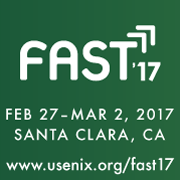sponsors
help promote
usenix conference policies
You are here
Innovations, Challenges, and Lessons Learned in HPC Storage Yesterday, Today, and Tomorrow
In this tutorial, we will introduce the audience to the lunatic fringe of extreme high-performance computing and its storage systems. The most difficult challenge in HPC storage is caused by millions (soon to be billions) of simultaneously writing threads. Although cloud providers handle workloads of comparable, or larger, aggregate scale, the HPC challenge is unique because the concurrent writers are modifying shared data.
We will begin with a brief history of HPC computing covering the previous few decades, bringing us into the petaflop era which started in 2009. Then we will discuss the unique computational science in HPC so that the audience can understand the unavoidability of its unique storage challenges. We will then move into a discussion of archival storage and the hardware and software technologies needed to store today’s exabytes of data forever. From archive we will move into the parallel file systems of today and will end the lecture portion of the tutorial with a discussion of anticipated HPC storage systems of tomorrow. Of particular focus will be namespaces handling concurrent modifications to billions of entries as this is what we believe will be the largest challenge in the exascale era.
The tutorial will end with a free-ranging audience directed panel.
- A brief history lesson about the past 30 years of supercomputers
- An understanding of what makes HPC computing unique and the entailing storage challenges
- An overview of current HPC storage technologies such as burst buffers, parallel file systems, and archival storage
- A glimpse into the future of HPC storage technologies for both hardware and software
- Insights into unique research opportunities to advance HPC storage



























connect with us